-
Publish Your Research/Review Articles in our High Quality Journal for just USD $99*+Taxes( *T&C Apply)
Offer Ends On
Mhd Azhar Ibrahim Kharsa*
Corresponding Author: Mhd Azhar Ibrahim Kharsa, Consultant Orthodontist & Dentofacial Orthopedist, PO Box 50492, 41523-Medina. KSA.
Received: November 01, 2025 ; Revised: November 05, 2025 ; Accepted: November 07, 2025 ; Available Online: November 10, 2025
Citation: Ibrahim Kharsa MA. (2025) Orthodontic Treatments Techniques with TADs. J Oral Health Dent Res, 5(2): 1-9.
Copyrights: ©2025 Ibrahim Kharsa MA. This is an open-access article distributed under the terms of the Creative Commons Attribution License, which permits unrestricted use, distribution, and reproduction in any medium, provided the original author and source are credited.
Views & Citations
Likes & Shares
Objectives: Mini-Screws, TADs and other Anchorage Devices like IZC "Infra-Zygomatic Crest" Mini-implants have changed the orthodontic practice drastically.
When starting the Mini-implants decades ago at the beginning of the 21st century, the practice, treatments and anchorage scheming have been carried to a new era and to a new juncture.
In this article the author discusses how TADs modify the orthodontic treatments in planning, biomechanics and even in the time consuming.
Presenting the lowdown, zeroing in on and fleshing out the modifications in the treatment plans citing examples of cases include:
Gummy Smile Treatments, Scissors-bite and Occlusal Cants where TADs fending off sufficiently.
Material and Methods: The author is clarifying the preponderance of evidences about how the Mini-screws techniques change the biomechanics in Orthodontics.
The article focuses on the following cases of:
- Gummy Smiles and the Role of TADs in their treatments.
- Crossbites & Scissors-bites and how the Temporary Anchorage Devices have changed their sequence of treatments.
- Impacted Teeth Treatment Developments by TADs and how the TADs improved the quality of treatments penned up previously the be tediously lingered.
- Occlusal Cants "Pitch, Roll & Yaw"; where TADs are playing eventually a quintessential role in their treatments.
Results: The Cases treated by author with TADs Techniques Modifications tap into the potentials of that promising domain of Orthodontics.
Conclusion: TADs have helped in the improvement of the Treatments qualities; they need modifications of the treatment notions ad hoc.
In plethora of cases the Temporary Anchorage Devices become a niche in the treatment quality and timing.
INTRODUCTION
The advent of “Temporary Anchorage Devices” TADs Changed a lot the Biomechanics Principe of Orthodontics with great panache.
The importance of TADs had been nothing short of a significant leap in sketching the treatment plans, solving the problems and hedging the Anchorage Units off the conventional wrought out schemes that depended on overloading the dental arches.
Nonetheless, to cover up the “riveting story” of the TADs in the Orthodontic Art & Practice; many articles detail in the published literatures, let alone the importance of the TADs in treatment of the following:
- TADs in Gummy-Smile treatment Cases.
- Treatment of Scissors-Crossbites Biomechanics in a spot of TADs applications
- Impacted Teeth Treatments where TADs can save the juxtaposing dental units off any deleterious counteractions.
- Occlusal Cant where TADs especially IZC “Infra-Zygomatic Crest” Mini-screws play a paramount important role in solving such quintessential matters.
The question about TADs safety has been a concern at their advent; however, the histologic studies have pointed out their reliability pertinent to the adjacent structures, Figures (1,2).
MATERIAL AND METHODS
TADs are of great magnitude when there is no sufficient anchorage to get along with the purposed movement(s).
Examples pertinent to such a conception are ample, however to present the lowdown of specific matters it’s of paramount importance to classify the topic into specific topics:
- Gummy Smiles and the Role of TADs in their treatments:
Gummy Smile Treatment is flummoxing especially when conventional treatments scupper the esthetic result of the patients’ appearance.
Wielding of surgery and the orthognathic approaches had been the clue for a long time, however, of late the advent of mini-screws has created a new embrasure within that battlement!
The technique in essence depends on installing two mini-screws in basal position to create a counter-clockwise movement of the maxillary arch as to counteract the causes of the gummy smile itself.
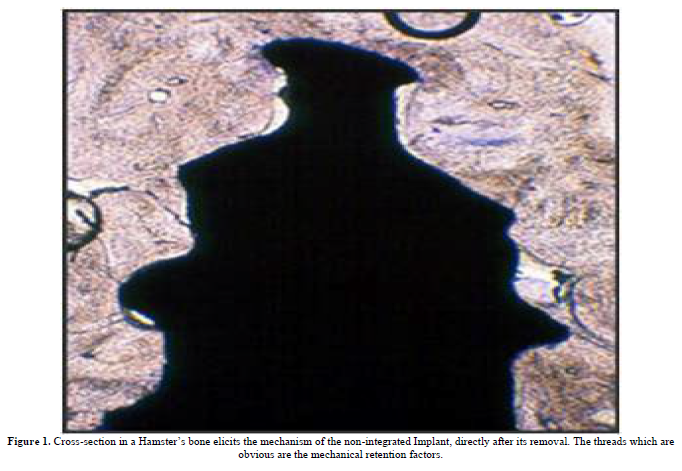
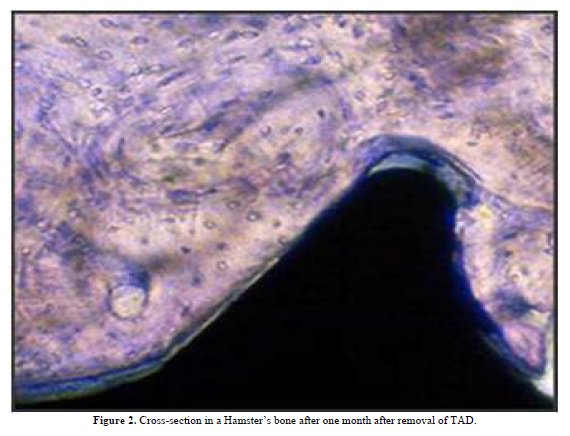
In other word, to create an intrusion Moment on the Anterior Portion of the Maxillary Arch what mollify the appearance of the exposed tissues when smiling in Gummy-Smile Patients (Figure 3).

The conventional treatments have been “maxed out” without vouching for any aesthetic result that could have solve the aesthetic problem of the patient of Figure 3.
The solution of TADs has improved the aesthetic appearance, the patient’s smile and even the patient’s Cupid’s bow “Smile Arc”, Figure 4, 5.
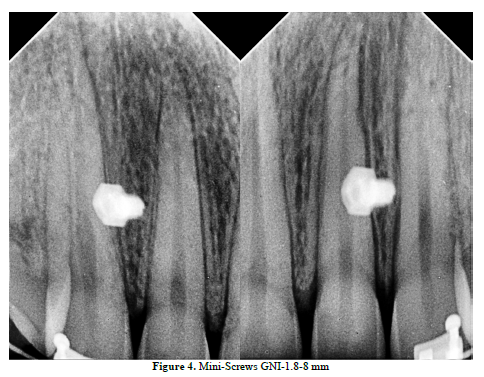
The advent of TADs Techniques has created a new path for “Gummy Smiles treatments”; as far along in such cases practitioners prefer the Orthognathic Approaches!
One question maybe asked:
Treatment of Gummy Smiles had been proven to be practical according to orthognathic & surgical solutions; so what are the motives to change the “Tide of Treatments History” into a new tackling?
It had been proven after TADs treatment of the Gummy Smile Cases that nothing short of groundbreaking technique for aesthetically and functionally correction.
Hitherto, the cephalometric and clinical outcomes support the aforementioned approach (Figure 6).
Nonetheless, the clinical aspects support the TADs wielded Gummy-Smile Corrections (Figure 7).
TADs are quintessentially helpful in Gummy Smile Treatments, however, it’s recommended that the practitioner get the lowdown on where & when to apply (Figure 8).


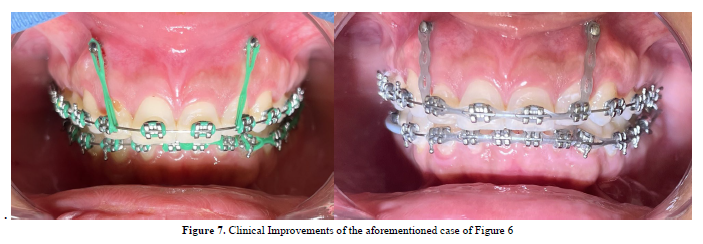
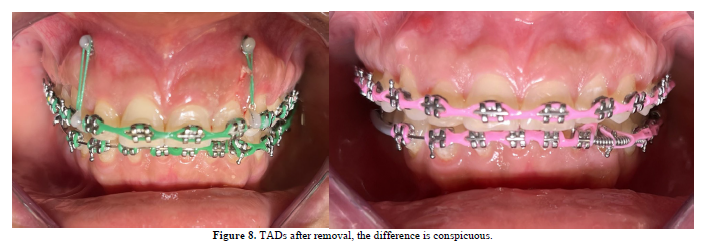
Treatment of Scissors-Cross-bites Biomechanics by TADs applying:
The Scissors-cross-bites a sort of flummox regarding orthodontic treatments, whereas the points of TADs proposed to be palatal most part in their treatments sequence.
TADs are of a paramount importance within treatment of scissors-bites (Figure 9,10), scheming the treatment plan is supposed to include the TADs pulling (Figure 11,12 & 13).

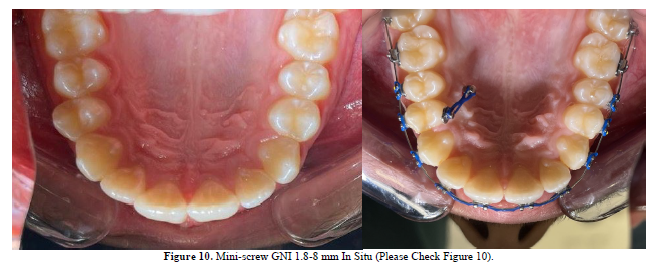
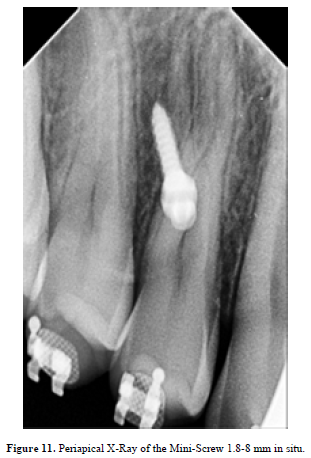
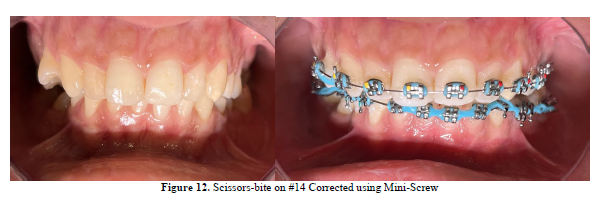
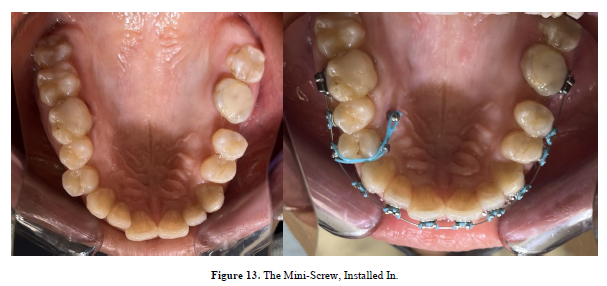
- Impacted Teeth Treatment using TADs:
Thanks to TADs as they move the needle in the Orthodontic Assisted Treatments if Impacted Teeth.
Especially when the impacted unit requites two-step orthodontic eruption, the Temporary Anchorage Device deprecates the adjacent teeth movements; decrease the negative flaws of the impacted unit(s) on the juxtaposed dental units.
Bearing the whole burden of the traction forces placates the aftermaths of the existence of the impacted dental unit(s), dwindles such negative consequences into zero (Figure 14).

- Occlusal Cant where TADs especially IZC “Infra-Zygomatic Crest” Mini-screws play a paramount important role in solving such quintessential matters:
TADs are of paramount importance when being “nidificated” to help in Transversal Cant Correction.
TADs are indicated for correction of the “Axis ROLL” of the Maxillary or Mandibular Arches.
The TADs help in solving the Orthodontic Transverse Problems, as they help in ensuring the anchorage fulcrum for solving such dilemmas.
To explain such a premise an example has been cited to get the lowdown on where to install the TAD(s) and what are the quintessential rolls of the TAD(s).
- The author fleshes out the aforementioned premise by citing an example about a case of a Nevus Flammeus “Port-Wine Stain” that caused a “perendinate” Transverse Dilemma of the Patient.
Fortunately, the TADs helped in correction of the pertinent Cant that had been caused by that Nevus Falmmeus (Figure 15).
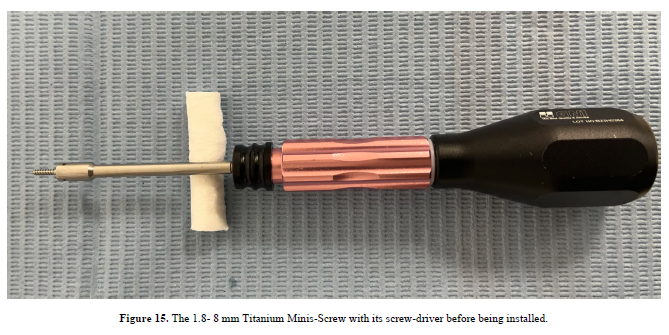
- TADs In Cleft-Lip-Palate Corrections:
One of the biomechanical applications of TADs is in the Cases of the Cross-bite Corrections in the Cleft-Lip-Palate Cases, ad libitum (Figure 16).
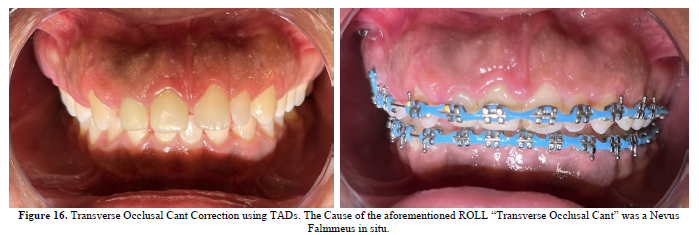
RESULTS
The Mini-Screws and Temporary Anchorage Devices TADs profoundly changed orthodontic biomechanics and practice (Figure 17).
Time of wrapping up the orthodontic treatments have been drastically decreased what is easily expounded by improvement of the anchorage “stilts”.
Additional research is recommended to carry on under the umbriferous outcomes of the TADs applications, statistics and groundbreaking outcomes.

CONCLUSION
TADs and Mini-screws suffice for most of the clinical applications in the sequence of treatments qualities and results, ad hoc.
In plethora of cases the Temporary Anchorage Devices become a niche in the treatment quality and timing.
No Files Found
Share Your Publication :